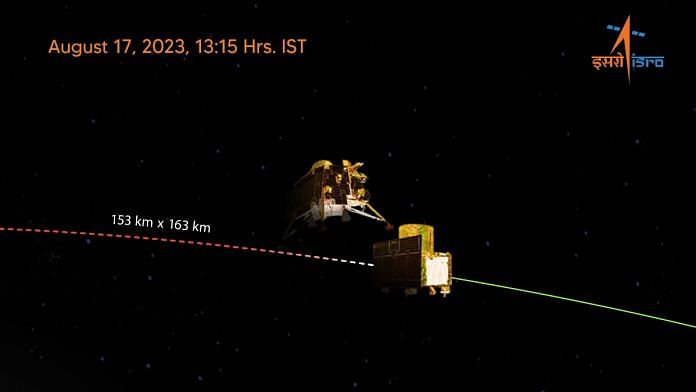New Delhi: The Vikram lander module of the Chandrayaan-3 spacecraft – which will attempt to make a soft landing on the moon later this month – was successfully separated from the propulsion module Thursday, marking a milestone in India’s third lunar mission.
After the critical manouevre, the Indian Space Research Organisation (ISRO) posted on X, “‘Thanks for the ride, mate! 👋’ said the Lander Module (LM). LM is successfully separated from the Propulsion Module (PM).”
The lander is set to descend to a slightly lower orbit tomorrow around 4 pm, ISRO further said.
Chandrayaan-3 Mission:
‘Thanks for the ride, mate! 👋’
said the Lander Module (LM).
LM is successfully separated from the Propulsion Module (PM)
LM is set to descend to a slightly lower orbit upon a deboosting planned for tomorrow around 1600 Hrs., IST.
Now, 🇮🇳 has3⃣ 🛰️🛰️🛰️… pic.twitter.com/rJKkPSr6Ct
— ISRO (@isro) August 17, 2023
Once it has safely landed, Vikram’s rover Pragyan will exit the lander and explore the surface. The 26-kg vehicle, equipped with solar panels, will move at the speed of 1 cm/sec.
Both Vikram and Pragyan are expected to function for one lunar day or 14 earth days, beyond which the lack of sunlight will cause the mission to lose power and the extreme cold of the lunar night will throttle its structure and equipment.
The Vikram lander, which is 8 ft 4 in × 6 ft 7 in × 3 ft 11, carries several payloads, among them the Chandra’s Surface Thermophysical Experiment (ChaSTE) to measure the thermal conductivity and temperature, Instrument for Lunar Seismic Activity (ILSA) to measure seismic activities around the landing site, and Langmuir Probe (LP) to estimate the moon’s surface plasma density and its variations.
In addition, a passive Laser Retroreflector Array from the National Aeronautics and Space Administration has also been accommodated for lunar laser ranging studies. This is meant to measure the distance between the earth and the moon using lasers fired from earth and reflected back from the moon.
Pragyan will carry an Alpha Particle X-ray Spectrometer (APXS) and Laser Induced Breakdown Spectroscope (LIBS) for studying the composition of the soil at the landing site.
Meanwhile, the propulsion module, which carries the Spectro-polarimetry of Habitable Planet Earth (SHAPE) payload, will continue to orbit the moon for several months – possibly years. It is designed to look for signs of exoplanets that have the potential to be habitable.
SHAPE, developed by U.R. Rao Satellite Centre in Bengaluru, will also perform a spectroscopic study of the earth’s atmosphere.
With Chandrayaan-3 launched on 14 July, India now has three crafts orbiting the moon. Chandrayaan-1 – launched in 2008 – had successfully helped identify the signatures of water on the lunar surface. Chandrayaan-2, launched in 2019, had also carried a lander to the moon but failed to soft-land it, preventing ISRO from rolling out the rover for further exploration of the lunar mission.
The current mission lacks a full-fledged satellite orbiter, but ISRO hopes to achieve a touchdown on 23 August. If successful, India is likely to become the fourth country to have done so.
Also read: Though launched after India’s Chandrayaan-3, why Russia’s Luna-25 rocket will land on moon first



